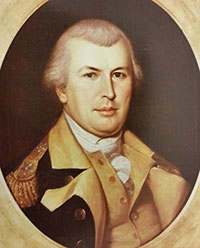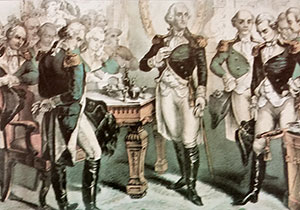 Eagle Feathers #314 – Second In Command
Eagle Feathers #314 – Second In Command
By Bob (Monty) Doherty
This article first appeared in the June 10,2015 edition of The Somerville Times
After the battle of April 19, 1775, which began in Lexington and ended in what is now Somerville, the budding country needed leaders. Out of the thirty-five American generals who served in the Revolutionary War, Rhode Island’s 33 year-old Nathanael Greene was the youngest. He was born in 1742, exactly one hundred years before Somerville’s birth in 1842.
He and his superior, General George Washington, were the only two generals to hold command for the entire length of the eight-year Revolutionary War. Their close relationship began at Prospect Hill where Washington promoted Greene to command that area. Prospect, meaning “wide view,” became the most prominent of the many fortifications surrounding Boston during its year-long siege. Washington’s headquarters were in Cambridge. Greene’s headquarters were located in a house that is now Saint Anthony’s Church and school yard at the corner of Somerville Avenue and Properzi Way. Greene Street, located off Summer Street, was named in his honor.

During that first year of the Revolution, strong family friendships began. At that time, many wives of officers and soldiers developed a common bond. Martha Washington, Catherine Greene, and their husbands became lifelong friends. The wives were treated to visits to Prospect Hill to experience its panoramic view of Boston. General Greene became Washington’s most trusted associate. He was later given command of all of the American forces fighting in the South. In this position, he would be in charge of the entire Continental Army if Washington fell in battle.

Nathanael idolized General Washington. The Washingtons had no children and were deeply moved and honored when the Greenes named their first son, George Washington Greene, and their first daughter, Martha Washington Greene.

At the war’s end, the state of Georgia gave land in Sarvannah to the Greenes. This was in appreciation of the General’s efforts during the conflict. After Greene’s death, his wife, Catharine, continued to run the farm. Eli Whitney, who was credited with the invention of the cotton gin, worked for her. Although he received the laurels, she played a big part in its design. He paid her royalties on his patent because she had provided him with ideas for the gin, financial help and a workshop to tinker in. It is important to note that during that time, women were not allowed to establish patents; hence, she received no official recognition.
General Nathanael Greene died of sunstroke in 1786, at the early age of 44, and is honored with a statues in Savannah and Washington D.C.
















Reader Comments